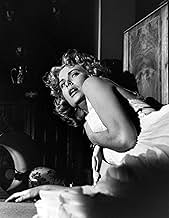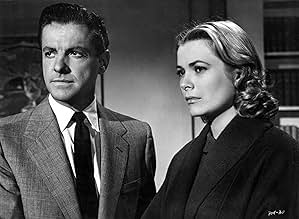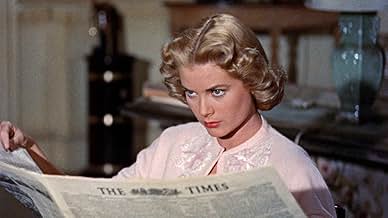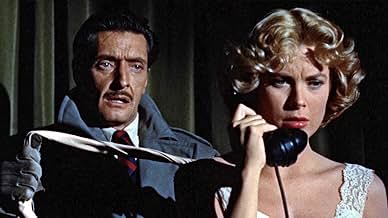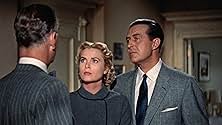Ein ehemaliger Tennisprofi schmiedet ein Komplott, seine Frau umzubringen. Als es misslingt, improvisiert er schnell einen Plan B.Ein ehemaliger Tennisprofi schmiedet ein Komplott, seine Frau umzubringen. Als es misslingt, improvisiert er schnell einen Plan B.Ein ehemaliger Tennisprofi schmiedet ein Komplott, seine Frau umzubringen. Als es misslingt, improvisiert er schnell einen Plan B.
- Nominiert für 1 BAFTA Award
- 5 Gewinne & 3 Nominierungen insgesamt
- Banquet Member
- (Nicht genannt)
- Detective
- (Nicht genannt)
- Bobby Outside Flat
- (Nicht genannt)
- Police Photographer
- (Nicht genannt)
- Detective
- (Nicht genannt)
- Woman Departing Ship
- (Nicht genannt)
- Banquet Member
- (Nicht genannt)
- Banquet Member
- (Nicht genannt)
Zusammenfassung
Empfohlene Bewertungen
However. it actually has a lot going for it, being beautifully shot in luminous colour, extremely well acted in almost every role and peppered throughout with those eye-catching and brain-satisfying flourishes which so distinguished the director from the rest.
Yes, it is very set-bound, betraying its stage origins and likewise very talky, especially on exposition, but it keeps the viewer alert throughout and delivers a neatly satisfying conclusion. I do wish Hitchcock could have done better with his back-projection unit (an old-fashioned, jarring trait he still hadn't grown out of by "Marnie" some 10 years later) and I occasionally found the constant too frivolous background music an intrusion, but it's well paced throughout, helped considerably by an on-form cast.
Ray Milland is excellent in a kind of darker Cary Grant type persona, Grace Kelly (who'd want to murder her?) goes convincingly from loveliness to wretchedness while it's pleasing to see Robert Cumming to the fore, recalled by Hitch for the first time in over a decade (since "Saboteur" in 1942). The actors playing the would be murderer and nosey police inspector are just fine too.
About those flourishes..., perhaps the most famous being the changing spotlight on Grace Kelly's doomed face as her trial is condensed into just a few terse minutes and of course the murder scene itself, even if one can't imagine her extended stabbing gesture being strong enough to cut through Swann's jacket far less kill him stone dead, but I also enjoyed the raised tracking shot looking down on Milland as he explains his plot to Swann and particularly the parting shadows of lovers Cumming and Kelly at Milland's unexpected approach.
Yes, it's old fashioned Hollywood movie-making, but it's old-fashioned Hollywood movie-making at its best and in my opinion an unjustly overlooked effort from the Master.
I'm working my way through Hitchcock's tremendous catalogue of films, I've kept this one til the end purposely, as I regard it as one of his best. It's suspenseful, it's intriguing, but best if all, it's clever.
Dial M for Murder has a genius plot, it is so clever, the plot is intricate and complicated, it never fails to impress me, so many details, and a spider's web that few could imagine.
I've been lucky enough to see this on stage a few times, it lends itself very well to The Theatre, this is one film I'd love to see retold.
I'm glad Ray Milland was cast as Tony, he's perfect in the role, he's charming and respectable, but has a wolfish like quality, the kind of guy that would shake your hand, then give you a black eye later on. Grace Kelly and Robert Cummings are terrific.
It's been adapted a few times, one version I quite enjoyed is a Perfect Murder, featuring Michael Douglas, it's not a patch on this, but it's very good.
I love that there's an intermission in it, it's a shame the third Lord of The Rings film didn't follow suit.
9/10.
Time has not diminished this gem and it deserves its fame and status.
Cold Ray Milland plans and sets up the murder of his demure but faithless wife Grace Kelly by a virtual stranger who is urged on by the stick of exposure of his misdeeds and the carrot of GBP1,000 in used notes. Of course all of his convoluted plans go horribly or thankfully wrong, depending on your point of view, leading to an even more convoluted revised plan. When first seen when young I wasted my time because I wasn't paying attention at the critical moment so missed the point and didn't get it: the key is how did the baddie get into the apartment? It's incredibly verbose, being from a stage play after all and at times it seems nothing more than a radio show with pictures. The long scene setting and verbal sparring by Milland and Anthony Dawson is superb to hear - it's fascinating for its relentless poetry, and of displaying a now-dead world. I could never understand the attraction of 3D movies, least of all with this particular attempt, or why Kelly was continually uglified by the Hollywood machine when she never looked lovelier than in here when she was playing stressed out throughout.
I wonder if Hitch remembered the jokey murder scene he did in 1930 in Elstree Calling when Jameson Thomas realised he was murdering in the wrong apartment? Turn that key you have and go in, it's a remarkably literate film and as intricate inside as any lock.
Wusstest du schon
- WissenswertesJohn Williams won the 1953 Tony Award for Best Featured Actor in a Play for "Dial M for Murder" as Inspector Hubbard. He re-created the role in this movie.
- PatzerWendice throws a £100 bundle on a pink armchair. The money falls right at the back of the seat. A few minutes later, Swann takes the money which is now right in front of the armchair.
- Zitate
Tony Wendice: How do you go about writing a detective story?
Mark Halliday: Well, you forget detection and concentrate on crime. Crime's the thing. And then you imagine you're going to steal something or murder somebody.
Tony Wendice: Oh, is that how you do it? It's interesting.
Mark Halliday: Yes, I usually put myself in the criminal's shoes and then I keep asking myself, uh, what do I do next?
Margot Mary Wendice: Do you really believe in the perfect murder?
Mark Halliday: Mmm, yes, absolutely. On paper, that is. And I think I could, uh, plan one better than most people; but I doubt if I could carry it out.
Tony Wendice: Oh? Why not?
Mark Halliday: Well, because in stories things usually turn out the way the author wants them to; and in real life they don't... always.
Tony Wendice: Hmm.
Mark Halliday: No, I'm afraid my murders would be something like my bridge: I'd make some stupid mistake and never realize it until I found everybody was looking at me.
- Crazy CreditsThe title is shown on a background of a British telephone dial; its MNO marking is replaced by a single large M which forms the single M of the title.
- Alternative VersionenThe film had an intermission in its original 3-D release, although it is less than two hours in length.
- VerbindungenEdited into Geschichte(n) des Kinos: Le contrôle de l'univers (1999)
Top-Auswahl
Details
- Erscheinungsdatum
- Herkunftsland
- Sprache
- Auch bekannt als
- Con M de Muerte
- Drehorte
- Produktionsfirma
- Weitere beteiligte Unternehmen bei IMDbPro anzeigen
Box Office
- Budget
- 1.400.000 $ (geschätzt)
- Bruttoertrag in den USA und Kanada
- 24.845 $
- Eröffnungswochenende in den USA und in Kanada
- 12.562 $
- 11. Apr. 1999
- Weltweiter Bruttoertrag
- 45.313 $
- Laufzeit
- 1 Std. 45 Min.(105 min)
- Farbe
- Seitenverhältnis
- 1.66 : 1



